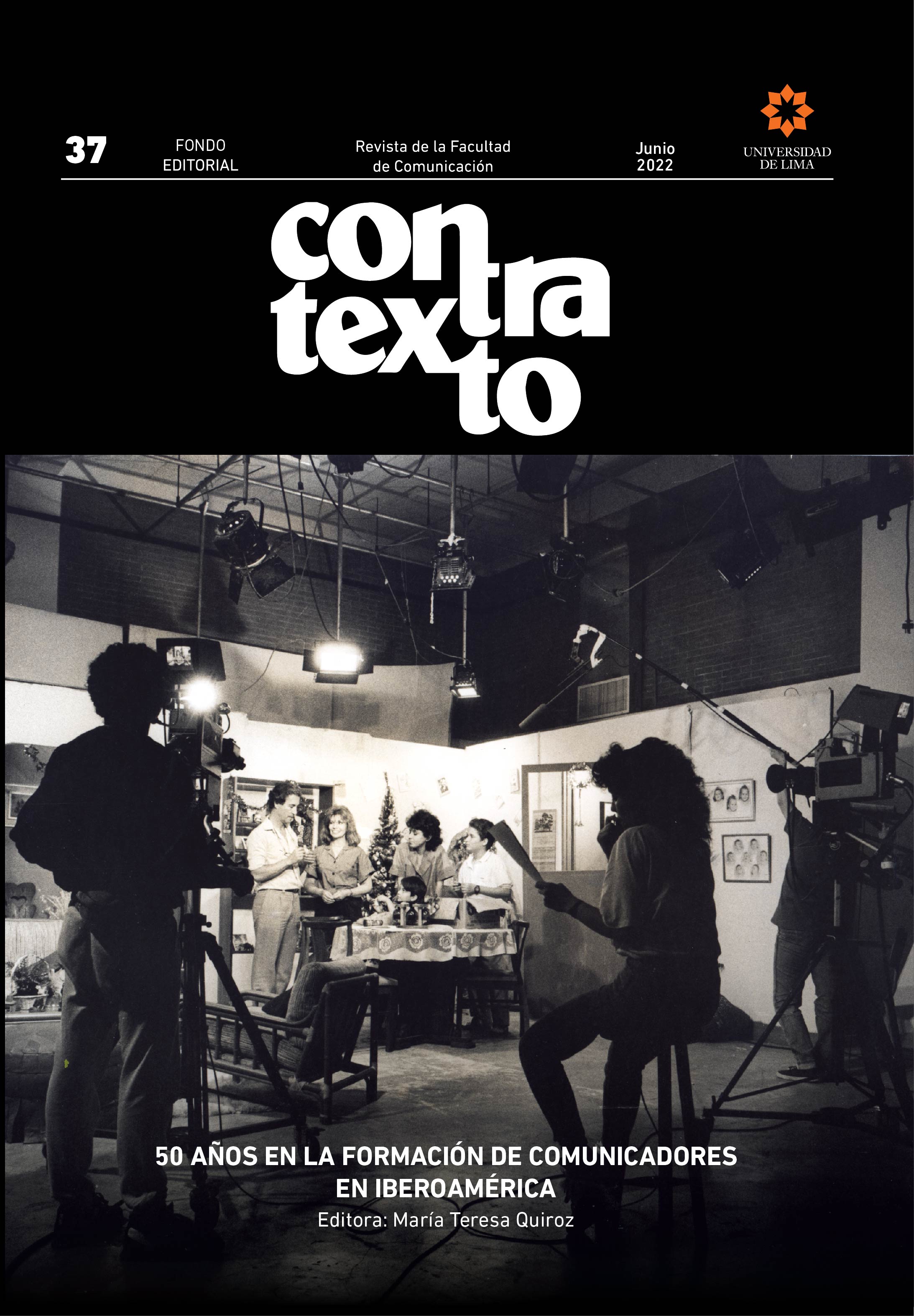Tecnologías y vida cotidiana: una revisión del modelo de domesticación
DOI:
https://doi.org/10.26439/contratexto2022.n037.5351Palabras clave:
domesticación de tecnologías, usos sociales de las tecnologías, vida cotidianaResumen
Ya han transcurrido veinticinco años desde que Roger Silverstone y otros investigadores propusieran a la domesticación —es decir, el proceso por el cual una especie animal o vegetal es transformada con el objeto de convivir con el ser humano— como una metáfora apropiada para comprender los modos en que los dispositivos tecnológicos son incorporados a la vida cotidiana de las personas, iniciando así el recorrido del modelo de domesticación de tecnologías. Esta propuesta resultó sumamente productiva en términos teóricos y empíricos, dando lugar a un conjunto de reflexiones e indagaciones que se convirtieron en parte del trasfondo habitual de la investigación acerca de los procesos de apropiación de tecnologías que se realiza desde una perspectiva sociocultural. Esta revisión presenta los principales lineamientos de su enfoque, reseña los resultados de las investigaciones que ha suscitado y discute sus límites y las adaptaciones necesarias para dar cuenta de los fenómenos tecnocomunicativos actuales
Descargas
Referencias
Appadurai, A. (Ed.). (1991). La vida social de las cosas. Perspectiva cultural de las mercancías. Grijalbo; Consejo Nacional para la Cultura y las Artes.
Asmolov, G. (2021). From sofa to frontline: the digital mediation and domestication of warfare. Media, War & Conflict, 14(3), 342-365. https://doi.org/10.1177/1750635221989568
Bakardjieva, M., & Smith, R. (2001). The internet in everyday life: computer networking from the standpoint of the domestic user. New Media & Society, 3(1), 67-83. https://doi.org/10.1177/1461444801003001005
Bijker, W. E. (1997). Of bicycles, bakelites, and bulbs. Toward a theory of sociotechnical change. MIT Press.
Birkland, J. (2013). A theory of ICT user types: exploring domestication and meaning of ICTS through comparative case studies [Disertación doctoral, Syracuse University]. https://surface.syr.edu/it_etd/77
Bolin, G. (2010). Domesticating the mobile in Estonia. New Media & Society, 12(1), 55-73. https://doi.org/10.1177/1461444809355112
Bourdieu, P. (2000). La distinción. Criterios y bases sociales del gusto. Taurus.
Brause, S. R., & Blank, G. (2020). Externalized domestication: smart speaker assistants, networks and domestication theory. Information, Communication & Society, 23(5), 751-763. https://doi.org/10.1080/1369118X.2020.1713845
Cabra Torres, F., & Marciales Vivas, G. P. (2009). Mitos, realidades y preguntas de investigación sobre los ‘nativos digitales’: una revisión. Universitas Psychologica, 8(2), 323-338.
De Reuver, M., Nikou, S., & Bouwman, H. (2016). Domestication of smartphones and mobile applications: a quantitative mixed-method study. Mobile Media & Communication, 4(3), 347-370. https://doi.org/10.1177/2050157916649989
De Schutter, B., Brown, J. A., & Vanden Abeele, V. (2015). The domestication of digital games in the lives of older adults. New Media & Society, 17(7), 1170-1186. https://doi.org/10.1177/1461444814522945
Douglas, M., & Isherwood, B. C. (1990). El mundo de los bienes. Hacia una antropología de consumo. Grijalbo; Consejo Nacional para la Cultura y las Artes.
Grošelj, D. (2021). Re-domestication of internet technologies: digital exclusion or digital choice? Journal of Computer-Mediated Communication, 26(6), 422-440. https://doi.org/10.1093/jcmc/zmab017
Grossberg, L. (2012). Estudios culturales en tiempo futuro. Cómo es el trabajo intelectual que requiere el mundo de hoy. Siglo XXI Editores.
Haddon, L. (1996). Explicaciones sobre el consumo de tecnologías de la comunicación y la información: el ejemplo del ordenador doméstico. En R. Silverstone & E. Hirsch (Eds.), Los efectos de la nueva comunicación (pp. 127-146). Bosch.
Haddon, L. (2003). Domestication and mobile telephony. En J. E. Katz (Ed.), Machines that become us: the social context of personal communication technology (pp. 43-55). Transaction Publishers.
Haddon, L. (2020). Domestication analyses and the smartphone. En R. S. Ling, L. Fortunati, G. Goggin, S. S. Lim & Y. Li (Eds.), The Oxford Handbook of Mobile Communication and Society (pp. 15-28). Oxford University Press.
Haddon, L. (2021). The domestication of touchscreen technologies in families with young children. En L. Green (Ed.), The Routledge Companion to Digital Media and Children (pp. 87-95). Routledge.
Haddon, L., & Green, N. (2009). Mobile communications. An introduction to new media. Berg.
Hall, S. (1980). Encoding/decoding. En S. Hall, D. Hobson, A. Lowe & P. Willis (Eds.), Culture, media, language. Working papers in cultural studies, 1972-79 (pp. 128-138). Routledge; Centre for Contemporary Cultural Studies, University of Birmingham.
Hantrais, L., Allin, P., Kritikos, M., Sogomonjan, M., Anand, P. B., Livingstone, S., Williams, M., & Innes, M. (2021). Covid-19 and the digital revolution. Contemporary Social Science, 16(2), 256-270. https://doi.org/10.1080/21582041.2020.1833234
Hartmann, M. (2009). La mirada etnográfica sobre el medio móvil. En J. M. Aguado & I. J. Martínez (Eds.), Sociedad móvil: tecnología, identidad y cultura (pp. 61-86). Biblioteca Nueva.
Hartmann, M. (2013). From domestication to mediated mobilism. Mobile Media & Communication, 1(1), 42-49. https://doi.org/10.1177/2050157912464487
Huang, Y., & Miao, W. (2020). Re-domesticating social media when it becomes disruptive: evidence from China’s “super app” WeChat. Mobile Media & Communication, 9(2), 177-194. https://doi.org/10.1177/2050157920940765
Hynes, D. (2009). [End] users as designers: the internet in everyday life in Irish households. Anthropology in Action, 16(1). https://doi.org/10.3167/aia.2009.160103
Hynes, D., & Richardson, H. J. (2009). What use is domestication theory to information systems research? En Y. K. Dwivedi, B. Lal, M. D. Williams, S. L. Schneberger & M. Wade (Eds.), Handbook of Research on Contemporary Theoretical Models in Information Systems (pp. 482-494). Information Science Reference.
Hynes, D., & Rommes, E. (2005). “Fitting the internet into our lives”: IT courses for disadvantaged users. En T. Berker, M. Hartmann, Y. Punie & K. Ward (Eds.), Domestication of media and technologies (pp. 123-44). Open University Press.
Kopytoff, I. (1991). La biografía cultural de las cosas: la mercantilización como proceso. En A. Appadurai (Ed.), La vida social de las cosas. Perspectiva cultural de las mercancías (pp. 89-122). Grijalbo; Consejo Nacional para la Cultura y las Artes.
Lago Martínez, S. (Ed.). (2015). De tecnologías digitales, educación formal y políticas públicas. Aportes al debate. Teseo.
Latour, B. (2001). La esperanza de Pandora. Ensayos sobre la realidad de los estudios de la ciencia. Gedisa.
Latour, B. (2012). Cogitamus: seis cartas sobre las humanidades científicas. Paidós.
Leong, L. (2020). Domesticating algorithms: an exploratory study of Facebook users in Myanmar. The Information Society, 36(2), 97-108. https://doi.org/10.1080/01972243.2019.1709930
Lim, S. S., & Wang, Y. (2021). Lessons from our living rooms: illuminating lockdowns with technology domestication insights. Journal of Children and Media, 15(1), 17-20. https://doi.org/10.1080/17482798.2020.1858909
Ling, R. (2002). Chicas adolescentes y jóvenes adultos varones: dos subculturas del teléfono móvil. Estudios de Juventud, 57, 33-46.
Ling, R. (2003). Fashion and vulgarity in the adoption of the mobile telephone among teens in Norway. En L. Fortunati, J. E. Katz, & R. Riccini (Eds.), Mediating the human body: technology, communication, and fashion (pp. 93-102). Routledge. https://doi.org/10.4324/9781410607768
Ling, R. (2012). Taken for grantedness: the embedding of mobile communication into society. MIT Press.
Martínez, C., & Olsson, T. (2021). Domestication outside of the domestic: shaping technology and child in an educational moral economy. Media, Culture & Society, 43(3), 480-496. https://doi.org/10.1177/0163443720948011
Matassi, M., Boczkowski, P. J., & Mitchelstein, E. (2019). Domesticating WhatsApp: family, friends, work, and study in everyday communication. New Media & Society, 21(10), 2183-2200. https://doi.org/10.1177/1461444819841890
Miao, W., & Chan, L. S. (2021). Domesticating gay apps: an intersectional analysis of the use of blued among Chinese gay men. Journal of Computer-Mediated Communication, 26(1), 38-53. https://doi.org/10.1093/jcmc/zmaa015
Montiel, J. (2021). “¡En la uni lo uso todo el tiempo!”: apropiación de teléfonos móviles entre jóvenes universitarios. En L. R. Sandoval (Ed.), Pantallas. Usos y representaciones en comunicación digital (pp. 49-71). Ediciones del Gato Gris.
Morley, D. (1996). Televisión, audiencias y estudios culturales. Amorrortu.
Morley, D. (2009). Medios, modernidad y tecnología. Hacia una teoría interdisciplinaria de la cultura. Gedisa.
Morley, D., & Silverstone, R. (1990). Domestic communication — Technologies and meanings. Media, Culture and Society, 12, 31-55.
Nimrod, G., & Edan, Y. (2021). Technology domestication in later life. International Journal of Human-Computer Interaction, 38(4), 339-350. https://doi.org/10.1080/10447318.2021.1938395
Oksman, V. (2006). Mobile visuality and everyday life in Finland: an ethnographic approach to social uses of mobile image. En J. R. Höflich & M. Hartmann (Eds.), Mobile communication in everyday life. Ethnographic views, observations and reflections (pp. 103-122). Frank & Timme. http://proxy2.hec.ca/login?url=http://site.ebrary.com/lib/hecm/Doc?id=10633964
Oksman, V. (2010). The mobile phone: a medium in itself. VTT. http://www.vtt.fi/inf/pdf/publications/2010/P737.pdf
Oksman, V., & Rautiainen, P. (2002). Toda mi vida en la palma de mi mano: la comunicación móvil en la vida diaria de niños y adolescentes de Finlandia. Estudios de Juventud, 57, 25-32.
Oksman, V., & Rautiainen, P. (2003). “Perhaps it is a body part”: how the mobile phone became an organic part of the everyday lives of Finnish children and teenagers. En J. E. Katz (Ed.), Machines that become us: the social context of personal communication technology (pp. 293-308). Transaction Publishers.
Pérez, I. (2009). La domesticación de la “tele”: usos del televisor en la vida cotidiana. Mar del Plata (Argentina), 1960-1970. Historia crítica, 39, 84-105.
Pérez, I. (2012). El hogar tecnificado: familias, género y vida cotidiana, 1940-1970. Editorial Biblos. http://site.ebrary.com/id/10689517
Pinch, T. J., & Bijker, W. E. (2008). La construcción social de hechos y de artefactos: o acerca de cómo la sociología de la ciencia y la sociología de la tecnología pueden beneficiarse mutuamente. En H. Thomas & A. Buch (Eds.), Actos, actores y artefactos: Sociología de la tecnología (pp. 19-62). Universidad Nacional de Quilmes.
Piscitelli, A. (2009). Nativos digitales. Dieta cognitiva, inteligencia colectiva y arquitecturas de la participación. Santillana.
Prensky, M. (2001). Digital natives, digital immigrants. On the Horizon, 9(5). http://www.marcprensky.com/writing/Prensky%20-%20Digital%20Natives,%20Digital%20Immigrants%20-%20Part1.pdf
Quandt, T., & Von Pape, T. (2010). Living in the mediatope: a multimethod study on the evolution of media technologies in the domestic environment. The Information Society, 26(5), 330-345. https://doi.org/10.1080/01972243.2010.511557
Richardson, H. J. (2009). A ‘smart house’ is not a home: the domestication of ICTs. Information Systems Frontiers, 11(5), 599-608. https://doi.org/10.1007/s10796-008-9137-9
Ruelas, A. L. (2014). El teléfono celular y los jóvenes sinaloenses. Adopción, usos y adaptaciones. Comunicación y Sociedad, 21, 101-131.
Russo Lemor, A. M. (2005). Making a “home”: the domestication of information and communication technologies in single parents’ households. En T. Berker, M. Hartmann, Y. Punie & K. Ward (Eds.), Domestication of media and technology (pp. 165-184). McGraw-Hill International.
Sandberg, H., Sjöberg, U., & Sundin, E. (2021). Toddlers’ digital media practices and everyday parental struggles: interactions and meaning-making as digital media are domesticated. Nordicom Review, 42(s4), 59-78. https://doi.org/10.2478/nor-2021-0041
Sandoval, L. R. (2019). La apropiación de tecnologías en América Latina: una genealogía conceptual. Virtualis, 10(19), 1-19.
Sandoval, L. R. (2020). La apropiación de tecnologías como proceso. Una propuesta de modelo analítico. En R. Canales Reyes & C. Herrera Carvajal (Eds.), Acceso, democracia y comunidades virtuales. Apropiación de tecnologías digitales desde el Cono Sur (pp. 33-49). CLACSO; Red de Investigadores sobre Apropiación de Tecnologías Digitales.
Sandoval, L. R. (en prensa). La domesticación de los smartphones: una panorámica teórica y metodológica. En S. Morales & E. Vidal (Eds.), ¿Quién se apropia de qué? Tecnologías digitales en el capitalismo de plataformas. CLACSO; Red de Investigadores sobre Apropiación de Tecnologías Digitales.
Sandoval, L. R., & Cabello, R. (2019). Límites a la domesticación: usos obligados, reticencia y austeridad en la apropiación de la telefonía móvil. Dixit, 31, 82-99. https://doi.org/10.22235/d.vi31.1849
Sgammini, M. (2011). Televisión y vida cotidiana: la domesticación del cable en Córdoba. Eduvim.
Silverstone, R. (1996). Televisión y vida cotidiana. Amorrortu.
Silverstone, R. (2005). Domesticating domestication: reflections on the life of a concept. En T. Berker, M. Hartmann, Y. Punie & K. Ward (Eds.), Domestication of media and technology (pp. 229-248). McGraw-Hill International.
Silverstone, R., & Haddon, L. (1995). Telework and the changing relationship of home and work. En N. W. Heap (Ed.), Information technology and society: a reader (pp. 400-412). Sage Publications; Open University.
Silverstone, R., Hirsch, E., & Morley, D. (1996). Tecnologías de la información y de la comunicación y la economía moral de la familia. En R. Silverstone & E. Hirsch (Eds.), Los efectos de la nueva comunicación (pp. 39-57). Bosch.
Søraa, R. A., & Fostervold, M. E. (2021). Social domestication of service robots: the secret lives of Automated Guided Vehicles (AGVs) at a Norwegian hospital. International Journal of Human-Computer Studies, 152, 102627. https://doi.org/10.1016/j.ijhcs.2021.102627
Søraa, R. A., Nyvoll, P., Tøndel, G., Fosch-Villaronga, E., & Serrano, J. A. (2021). The social dimension of domesticating technology: interactions between older adults, caregivers, and robots in the home. Technological Forecasting and Social Change, 167, 120678. https://doi.org/10.1016/j.techfore.2021.120678
Uwamariya, M., Loebbecke, C., & Cremer, S. (2021). Mobile money adoption in rural Rwanda: a domestication perspective. Africa Journal of Management, 7(2), 314-337. https://doi.org/10.1080/23322373.2021.1902209
Vuojärvi, H., Isomäki, H., & Hynes, D. (2010). Domestication of a laptop on a wireless university campus: a case study. Australasian Journal of Educational Technology, 26(2). https://doi.org/10.14742/ajet.1094
Ward, K. (2005). The bald guy ate an orange: domestication, work and home. En T. Berker, M. Hartmann, Y. Punie & K. Ward (Eds.), Domestication of media and technology (pp. 145-164). McGraw-Hill International.
Watson, A., Lupton, D., & Michael, M. (2021). The COVID digital home assemblage: transforming the home into a work space during the crisis. Convergence: The International Journal of Research into New Media Technologies, 135485652110308. https://doi.org/10.1177/13548565211030848
Winocur, R. (2009). Robinson Crusoe ya tiene celular: la conexión como espacio de control de la incertidumbre. Universidad Autónoma Metropolitana, Unidad Iztapalapa; Siglo Veintiuno Editores.
Winocur, R., & Sánchez Vilela, R. (2016). Familias pobres y computadoras. Claroscuros de la apropiación digital. Planeta.
Yarto Wong, C., & Pedroza Villarreal, G. (2013). El uso del teléfono celular y sus implicaciones socioculturales. En A. Alfonso (Ed.), Comunicación y estudios socioculturales: miradas desde América Latina (pp. 291-306). Universidad Nacional de Quilmes.
Publicado
Número
Sección
Licencia
Todos los trabajos publicados están sujetos a una licencia CC BY 4.0 Creative Commons (actualizado el 1 de marzo de 2021).
El contenido de la revista se puede compartir en cualquier material o formato. Asimismo, se puede adaptar, contribuir y transformar. Ambas posibilidades sólo están permitidas en la medida en que cumplan las siguientes condiciones:
- Atribución: Se debe otorgar crédito donde sea debido, proporcionar un enlace a la licencia e indicar los cambios en caso se realice alguno. Esto debe hacerse de la manera que se considere apropiada, sin sugerir que el licenciante lo promueva a usted o su uso del material.
Derechos de propiedad
Los derechos patrimoniales de Contratexto se publican bajo una licencia Creative Commons BY 4.0, lo que permite a los autores mantener los derechos patrimoniales de su obra sin restricciones.
Si un trabajo publicado en Contratexto fuera copiado, distribuido, difundido o cualquier otra actividad contemplada en la licencia antes mencionada, se deberá mencionar de manera visible y expresa al autor o autores y a la revista.
Auto-archivo
Esta revista permite y anima a los autores/as a publicar artículos enviados a la revista en sus sitios web personales o en depósitos institucionales, tanto antes como después de su publicación en esta revista, siempre y cuando proporcionen información bibliográfica que acredite, si procede, su publicación en ella.


















